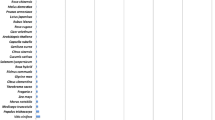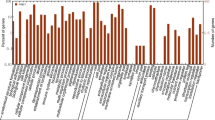Abstract
Expressed sequence tags (ESTs) are providing a valuable approach to sampling organism-expressed genomes, especially when studying large genomes such as those of many plants. We report on the comparison of 8,647 ESTs generated from six different grape (Vitis vinifera L.) organs: berry, root, leaf, bud, shoot and inflorescence. Clustering and assembly of these ESTs resulted in 4,203 unique sequences and revealed that at this level of EST sampling, each organ shares a low percentage of transcripts with the others. To define organ relationships based on EST counts, we calculated a distance matrix of pairwise correlation coefficients between the libraries which indicated bud, inflorescence and shoot as a group distinct from the other organs considered in this study. A putative function was identified for about 85% of the unique sequences. By assigning them to specific functional classes, we were able to highlight strong differences between organs in the metabolism, protein biosynthesis and photosynthesis categories. This grape EST collection has also proven to be a valuable source for the development of ‘functional’ simple sequence repeats (SSRs) markers: a total of 405 SSRs have been identified. EST sequences and annotation results have been organised in the IASMA-grape database, freely available at the address http://genomics.iasma.it.




Similar content being viewed by others
References
Ablett E, Seaton G, Scott K, Shelton D, Graham MW, Baverstock P, Lee LS, Henry R (2000) Analysis of grape ESTs: global gene expression patterns in leaf and berry. Plant Sci 159:87–95
Adams MD, Kelley JM, Gocayne JD, Dubnick M, Polymeropoulos MH, Xiao H, Merril CR, Wu A, Olde B, Moreno RF (1991) Complementary DNA sequencing: expressed sequence tags and human genome project. Science 252:1651–1656
Aharoni A, Vorst O (2002) DNA microarrays for functional plant genomics. Plant Mol Biol 48:99–118
Altschul SF, Madden TL, Schaffer AA, Zhang J, Zhang Z, Miller W, Lipman DJ (1997) Gapped BLAST and PSI-BLAST: a new generation of protein database search programs. Nucleic Acids Res 25:3389–3402
Baiges I, Schaffner AR, Mas A (2001) Eight cDNA encoding putative aquaporins in Vitis hybrid Richter-110 and their differential expression. J Exp Bot 52:1949–1951
Bausher M, Shatters R, Chaparro J, Dang P, Hunter W, Niedz R (2003) An expressed sequence tag (EST) set from Citrus sinensis L. Osbeck whole seedlings and the implications of further perennial source investigations. Plant Sci 165:415–422
Bhalerao R, Keskitalo J, Sterky F, Erlandsson R, Bjorkbacka H, Birve SJ, Karlsson J, Gardestrom P, Gustafsson P, Lundeberg J, Jansson S (2003) Gene expression in autumn leaves. Plant Physiol 131:430–442
Boss PK, Buckeridge EJ, Poole A, Thomas MR (2003) New insights into grapevine flowering. Funct Plant Biol 30:593–606
Cardle L, Ramsay L, Milbourne D, Macaulay M, Marshall D, Waugh R (2000) Computational and experimental characterization of physically clustered simple sequence repeats in plants. Genetics 156:847–854
Carninci P, Shibata Y, Hayatsu N, Sugahar, Y, Shibata K, Itoh M, Konno H, Okazaki Y, Muramatsu M, Hayashizaki Y (2000) Normalization and subtraction of cap-trapper-selected cDNAs to prepare full-length cDNA libraries for rapid discovery of new genes. Genome Res 10:1617–1630
Chang S, Puryear J, Cairney J (1993) A simple and efficient method for isolating RNA from pine trees. Plant Mol Biol Reptr 11:113–116
Cordeiro GM, Casu R, McIntyre CL, Manners JM, Henry RJ (2001) Microsatellite markers from sugarcane (Saccharum spp.) ESTs cross transferable to erianthus and sorghum. Plant Sci 160:1115–1123
Davies C, Robinson SP (2000) Differential screening indicates a dramatic change in mRNA profiles during grape berry ripening. Cloning and characterization of cDNAs encoding putative cell wall and stress response proteins. Plant Physiol 122:803–812
Eibach R, Toepfer R (2003) Success in resistance breeding: “Regent” and its steps into the market. Acta Hortic (ISHS) 603:687–691
Esau K (1965) Plant anatomy. 767. Wiley, 65
Ewing B, Hillier L, Wendl MC, Green P (1998) Base-calling of automated sequencer traces using phred. I. Accuracy assessment. Genome Res 8:175–185
Ewing RM, Ben Kahla A, Poirot O, Lopez F, Audic S, Claverie JM (1999) Large-scale statistical analyses of rice ESTs reveal correlated patterns of gene expression. Genome Res 9:950–959
Fernandes J, Brendel V, Gai X, Lal S, Chandler VL, Elumalai RP, Galbraith DW, Pierson EA, Walbot V (2002) Comparison of RNA expression profiles based on maize expressed sequence tag frequency analysis and micro-array hybridization. Plant Physiol 128:896–910
Fraser LG, Harvey CF, Crowhurst RN, De Silva HN (2004) EST-derived microsatellites from Actinidia species and their potential for mapping. Theor Appl Genet 108:1010–1016
Gao LF, Tang JF, Li HW, Jia JZ (2003) Analysis of microsatellites in major crops assessed by computational and experimental approaches. Mol Breed 12:245–261
Huang X, Madan A (1999) CAP3: a DNA sequence assembly program. Genome Res 9:868–877
Lee NH, Weinstock KG, Kirkness EF, Earle-Hughes JA, Fuldner RA, Marmaros S, Glodek A, Gocayne JD, Adams MD, Kerlavage AR (1995) Comparative expressed-sequence-tag analysis of differential gene expression profiles in PC-12 cells before and after nerve growth factor treatment. Proc Natl Acad Sci U S A 92:8303–8307
Lodhi MA, Reisch BI (1995) Nuclear-DNA content of Vitis species, cultivars, anti other genera of the Vitaceae. Theor Appl Genet 90:11–16
Moser C, Gatto P, Moser M, Pindo M, Velasco R (2004) Isolation of functional RNA from small amounts of different grape and apple tissues. Mol Biotechnol 26:95–100
Obayashi T, Okegawa T, Sasaki-Sekimoto Y, Shimada H, Masuda T, Asamizu E, Nakamura Y, Shibata D, Tabata S, Takamiya K, Ohta H (2004) Distinctive features of plant organs characterized by global analysis of gene expression in Arabidopsis. DNA Res 11:11–25
Quackenbush J (2001) Computational analysis of microarray data. Nat Rev Genet 2:418–427
Quackenbush J, Cho J, Lee D, Liang F, Holt I, Karamycheva S, Parvizi B, Pertea G, Sultana R, White J (2001) The TIGR Gene Indices: analysis of gene transcript sequences in highly sampled eukaryotic species. Nucleic Acids Res 29:159–164
Robinson SP, Davies C (2000) Molecular biology of grape berry ripening. Aust J Grape Wine Res 6:175–188
Rudd S (2003) Expressed sequence tags: alternative or complement to whole genome sequences? Trends Plant Sci 8:321–329
Scott KD, Eggler P, Seaton G, Rossetto M, Ablett EM, Lee LS, Henry RJ (2000) Analysis of SSRs derived from grape ESTs. Theor Appl Genet 100:723–726
Terrier N, Ageorges A, Abbal P, Romieu C (2001) Generation of ESTs from grape berry at various developmental stages. J Plant Physiol 158:1575–1583
Thiel T, Michalek W, Varshney RK, Graner A (2003) Exploiting EST databases for the development and characterization of gene-derived SSR-markers in barley (Hordeum vulgare L.). Theor Appl Genet 106:411–422
Varshney RK, Thiel T, Stein N, Langridge P, Graner A (2002) In silico analysis on frequency and distribution of microsatellites in ESTs of some cereal species. Cell Mol Biol Lett 7:537–546
Acknowledgements
We wish to thank Claudio Varotto for his critical evaluation of the manuscript and Anita Zamboni and Marco Stefanini for providing technical support. This work was supported by the ‘Advanced Biology’ project funded by the Fondazione delle Casse di Risparmio di Trento e Rovereto (Trento, Italy). P.G. and M.P. are recipients of fellowships granted by the Fondo Unico of the Province of Trento, ‘Resveratrol’ and ‘BAC-co’, respectively. I.S. was supported by the research circle of German Viticulture (Forschungsring des Deutschen Weinbaues, FDW) of the German Society for Agriculture. Bernhard Korn (RZPD, German Resource for Genome Research) was helpful in the initial phases of cDNA cloning.
Author information
Authors and Affiliations
Corresponding author
Additional information
Moser and Segala contributed equally to this work
Rights and permissions
About this article
Cite this article
Moser, C., Segala, C., Fontana, P. et al. Comparative analysis of expressed sequence tags from different organs of Vitis vinifera L.. Funct Integr Genomics 5, 208–217 (2005). https://doi.org/10.1007/s10142-005-0143-4
Received:
Revised:
Accepted:
Published:
Issue Date:
DOI: https://doi.org/10.1007/s10142-005-0143-4




